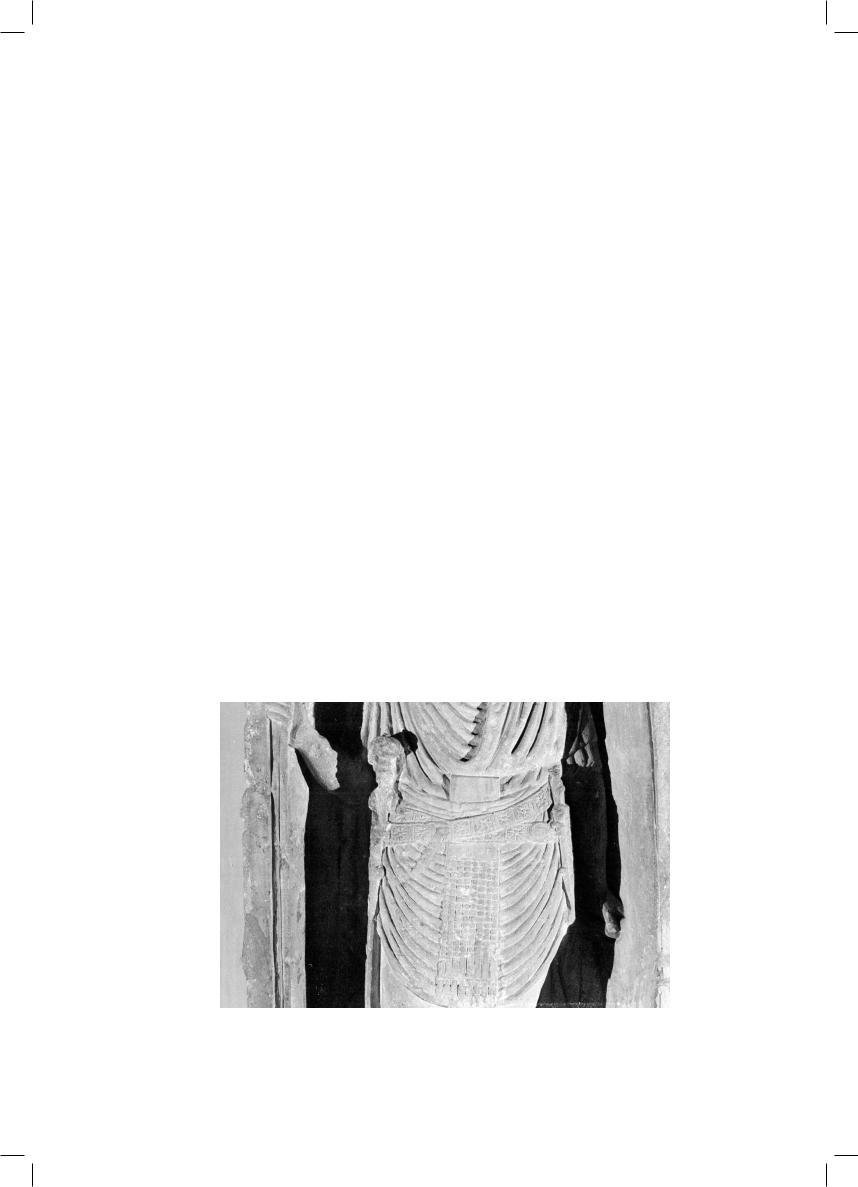
Pugio_-_Gladius_brevis_est
.pdf
FOREWARD
Archaeologists excavate and from these excavations, they produce finds of ancient artefacts, sometimes complete but often only fragmentary.Thisis wherethefun starts.These findshave tobecompared to others, from known contexts, withaview tounderstandingtheirfunctionandestablishingtheirdates.Thisinvolvessearchingthroughpreviouspublications,inlearned journalsthatarenotalwayseasytoobtain.Whenthishappens,itisveryusefultobeabletomakeuseofa‘one-stop’volume
– a catalogue in fact – where there are many examples listed, together with the main facts about them. This is precisely what Marco Saliola and Fabrizio Caprini have produced here for the Roman ‘small-arms’weapon, the pugio.
Were this all they had produced, it would still be a valuable addition to the archaeologist’s set of tools. They have, however, gone much further than this. They have examined the history of the weapon, its construction, its strengths and weaknesses as a weapon, its likely use, its artistic representation and they have structured the catalogue around a useful typology.
In short, I would suggest that they have produced as complete an examination of the pugio as it is possible to achieve.
Mike Thomas
Newport, Monmouthshire,
March, 2012
Libro inglese BAR [A4].indd |
1 |
27/05/2012, 16.23 |

PUGIO - GLADIUS BREVIS EST
Cover: |
|
|
Title: |
in the foreground: |
citation by Nonius Marcellus, “De Compendiosa Doctrina”, Book 19; |
Image: |
photo of a pugio from a private collection (photo by the author); |
|
|
in the background: |
photo of a pugio from the collection |
|
|
of the Romisch-Germanisches Zentralmuseum |
|
further in the background: |
(Mainz-Germania) (photo by the author); |
|
photo of a pugio from a private collection (photo by the author); |
|
|
in the far background: |
detail from the stele ofAnnaius Daverzua, |
|
|
presently in the collection of the Sclossparkmuseum |
|
|
(Bad Kreuznach – Germania). |
|
|
2 |
Libro inglese BAR [A4].indd |
2 |
27/05/2012, 16.23 |

CONTENTS |
|
|
Introduction |
5 |
|
FIRST PART – THE WEAPON |
|
|
chap. I |
origins, evolution and classification |
7 |
chap. II |
geographical distribution |
25 |
chap. III |
distribution within the army |
35 |
chap. IV |
function and use |
39 |
SECOND PART – TECHNOLOGYANDACCESSORIES |
|
|
chap. V |
construction technology |
47 |
chap. VI |
sheaths |
57 |
TIRTH PART – HISTORICALSOURCES |
|
|
chap. VII |
iconographical sources |
75 |
chap. VIII |
classical citations |
85 |
chap. IX |
database of archaeological findings |
103 |
Conclusions |
133 |
|
Bibliography |
135 |
|
Acknowledgements |
141 |
|
3
Libro inglese BAR [A4].indd |
3 |
27/05/2012, 16.23 |

PUGIO - GLADIUS BREVIS EST
4
Libro inglese BAR [A4].indd |
4 |
27/05/2012, 16.23 |

INTRODUCTION
“The Romans were victorious over all peoples thanks only to the execution of their arms. In fact, we can see that it is by no other means that the Roman people conquered the world other than by the execution of their arms, their discipline on the field, and their military experience.”1
Rome has been a reference point in history for many reasons: for its organisation of the State, for its Art and Culture,foritsLawandmuchmore;tothepointofleaving a profound and permanent mark on both the ancient and modern western world. However, “if it was capable of building a vast and lasting empire, it was evidently able to achieve this thanks to its troops”2, and these troops were victorious over the people of the time also thanks to their weapons.
The aim of this book is to examine in depth one of these weapons, the PUGIO
The pugio (pl. pugiones) is a short weapon of offence of the Roman army, also famous for being the weapon with which Julius Caesar was killed, and it represents in the collective imagination a characteristic weapon of the Roman legionary. Its rich decoration and the use of precious metals have given it a legendary air, which has been favoured by a scarcity of literary sources and the lack of a clear explanation of its function or the specific use soldiers made of it.
Due to a lack of in-depth studies which would lead to an adequateplacementoftheweapon,thelackofinformation regarding the pugio has been filled to this day by simple deductions on the part of modern authors, which are frequently no more than personal assumptions.
The persistent presence of pugiones in the Roman infantryman’s panoply over an uninterrupted period of almost four centuries, which goes from the Republic (end of II century B.C) to the crisis of The Empire (mid III
century A.D.) is proof of the importance of this dagger. Such evidence, however, contrasts with the limited diffusion of the weapon in a precise territorial context - that of the “Limes (border) of the Rhine and high Danube” - rendering the pugio a far from indispensible weapon in comparison with the gladius, whose use is observed throughout the Roman world.
The latin term “Pugio” derives from the verb “pungo” and corresponds with the Greek term “ἐγχειρίδιον”. The root of the word is “pug” which belongs to a group of terms with the meaning shock, and in the case of pugio means “physical blow, given by a sharp point”. It must be distinguished from the etymology of dagger (“pugnale” in Italian) which rather derives from “pugnus”, with the meaning of fist (“pugno” in Italian): the way in which the weapon was held. In both meanings, pugio and dagger (in Italian the translation of “dagger” is pugnale), the type of combat implied is that of “pugna”, that is to say combat where physical contact is expected between the two rivals: so-called “hand-to-hand” combat. The word derives from the Indo-European root “-peu^g”, which means “daggerclub”3, which is proof that the name given to this dagger is much older than the weapon as we perceive it today, possibly implying that there are precursors to it unknown to us at present. The pugio is a unique weapon of its kind, doubtlessly part of the Roman military culture (apart from some early models whose Celtiberian origin makes it difficult to assign the most ancient of them with any precision: the similarity in form of the daggers and the sharing of territories of the two peoples raising doubts for manyarchaeologicalfinds). Ithasanunusualhandle,with two pommels, the first of which is at the top and the other in the centre of the grip, which, despite the technological changesincurredoverthecourseoffourcenturies,makesit easilydistinguishableevenbyanon-expertinthisweapon. It doesn’t have a prominent guard, which excludes a priori a duel-type purpose, whereas the blade is often waisted, in the shape of a Weeping Willow leaf, with a variation in the form which has over time more or less emphasized its characteristics, often reflecting the evolution of the
Fig.1: tombstone s byAnnaius Daverzus, auxiliary foot soldier of IV Choors Delmatarum, shows us with great clarity the weapon which is the object of this book, hanging from a beautiful cingulum on the left side of the legionary.
5
Libro inglese BAR [A4].indd |
5 |
27/05/2012, 16.23 |

PUGIO - GLADIUS BREVIS EST
gladius. In fact, the symbiosis between the pugio and the gladius was almost always very close, so much so that we can state that “Pugio est gladius brevis”4.
The best sources of information leading to our knowledge and understanding of this weapon are represented by archaeological finds, iconography and literary documentation, upon which this book has been based in an attempt to understand its symbolic role and meaning in antiquity. Known exemplars constitute an exhaustive object of study and give us quite a complete range of the various types of construction and places of origin, suggesting the places where these weapons were most widelyused.Thecenotaphs-sepulchralmonumentswhich did not contain mortal remains - contribute enormously to our present knowledge, with their detailed representations of the Miles5. The Romans were not actually accustomed to entomb their dead soldiers with all their weapons, as was typical for some peoples, such as the Etruscans and Celts, and this behaviour has deprived us of an enormous potential source of finds. In any case, the military tombstones partly compensate for this loss of information, by depicting details of clothing and equipment belonging to the deceased, as well as relating to us by means of the surviving epitaphs where the Miles was stationed, his name, and the military corps he belonged to.
Finally, great help has been given to us by way of classical literature, whose references go from the first century BC until approximately the XII-XIII century AD. Attentive study of this allows us to identify precious information and indications. There are numerous classics authors who speak about the weapon in question, however, it is unfortunate that they never give detailed descriptions of the pugiones and rarely of a fact relating to war in which the battle technique and the specific use of the weapon are narrated. This is hardly surprising as the classics authors never stop to describe any weapon in detail, whether it an offensive weapon, such as the pugio or the gladius, or a defensive one, such as the helmet or lorica. Instead, they go into greater detail regarding the tactical aspect, the military formation or organisation of the army. Ancient literaryworkswere,infact,addressedtohighsocialclasses where, during banquets and in cultural circles (such as the Club of Scipions), aristocratic and imperialistic ideology was elaborated, and where discussion was based on an explanation for Roman superiority over the rest of the population,ortheso-calledbarbarians.Thispredominance was described in heroic feats which made Rome great, as for example in Polybius’s6 exaltation of the war strategy used in various punic wars (even if this was by means of betrayal and lack of respect for signed treaties), the realisation of impossible deeds and feats, such as the construction of the bridge over the Rhine, the siege of Alesia and the conquest of Britannia7, or the storming of the city of Jerusalem and the fortress of Masada8. In the detailed description of the feat there can be no room for a description of the weapons and their use because these were the subject matter of discourse among soldiers, and not of interest within a literary circle or in a military treaty, such as those written by Polybius, Josephus Flavius and Publius Flavius Vegetius.
Regarding the literary sources of the time, the phenomenon is summed up by the quotation that “in the endless biographies on the Roman army, its organisation, social, cultural and economic aspects, very few studies have been dedicated to the type of weapons used and their production”9. Furthermore, military coverage is mainly in the form of Anglo Saxon and German studies, as if the most enthusiastic experts in the subject came from those nations which paradoxically housed the Roman Limes and, therefore, the greatest number of legions, and in some ways were subjected to Roman dominance. In any case, not many authors have decided to study our weapon in more depth, generally preferring to concentrate on other components of the Roman panoply or the study of the army in general.
The essence of this work is in its proposal to fill this gap, attempting to base its finds exclusively on indisputable data and sources and avoiding personal considerations which could easily mislead a correct evaluation. Essentially the Pugio, as the subject of our study, will lead us through the history and evolution of the Roman army. It will accompany us on our way to a discovery and deeper knowledge of many aspects - sometimes not well known but certainly important - in order to understand better the characteristics and the mentality of this extraordinary, ancient army.
1 |
Vegetius, “Epitoma rei militaris”, book I |
2 |
Yann Le Bohec, “L’esercito romano”, ed. Carocci |
3 |
G. Köbler, “Indogermanisches Wörterbuch”, München, 1981; |
4 |
Nonius Marcellus, “De compendiosa Doctrina” LLA615, book 19, meaning “the pugio is a short gladius”; |
5 |
basic foot soldier in Latin ; |
6 |
in his work “Historiae”; |
7 |
Julius Caesar,”De Bello Gallico”; |
8 |
Josephus Flavius, “De Bello Judaico”; |
9 |
VincenzoAiello,”Le armi nel mondo tardo antico”; |
6
Libro inglese BAR [A4].indd |
6 |
27/05/2012, 16.23 |

CHAPTER I
ORIGINS, EVOLUTIONAND CLASSIFICATION
“One of the greatest problems in the academic debate is that terminology identifies groups which do not actually exist as such. The modern historian needs to group together different civilisations.” 1
Classificationisafundamentalconceptinthechronological research of a weapon. However, as I cannot but agree with the above-mentioned concept, the classification proposed here is consequently based on three main types, all possessing real and evident characteristics. That is to say that it only considers well-defined evolutionary differences and is not the fruit of the almost certainly differing styles and civilisations of the armourers who created the weapons.
This notwithstanding, as with every classification, its quality is in its explanation - in this case of the evolution of the weapon over time - but it is inevitably limited by a potentially excessive simplification and rigidity which doesnotalwaysmirrortheprecisehistoricalrealityofeach single object.
This chapter, furthermore, aims to follow the evolution of the weapon over the centuries, from its first appearance in the panoply of the Roman legion until its final disappearance, without neglecting to investigate its genesis.
Let us, therefore, use this as our starting point.
When there is a lack of indisputable historical sources, the origins of an ancient weapon are very difficult to identify. Therefore, we will reconstruct them, beginning with the archaeological and historical evidence at hand.
There is no doubt that the origins are to be sought for within the Hispanic culture and, more precisely, there is no doubt that the Roman pugio derives directly from the biglobular Celtiberian dagger2. Short edge weapons coming from Italic and central European territories, instead, are of no particular influence. This appears to be quite a surprising anomaly, in fact, one might wonder why the Romans did not emulate the use of short edge weapons by the great peoples who lived at close quarters with them, rather than competing with the Celtiberians3, as for example the Samnites, the Etruscans, and the Celts of the Italic territories, etc.
In actual fact, the explanation is quite plausible, and is to be found not in the craftsmanship of the weapon or in the construction techniques, but rather in the use that was it was intended for. The fundamental difference is that in the period of the Roman Republic the dagger was a weapon purely used for battle purposes on the Iberian peninsula4, whereas in the Hellenic, Italic and central European territories it was intended rather as a symbolic object.
From a military point of view, it is connected with the tactical method of combat.
TheRomansandIberianswereverysimilarfromthispoint
of view and followed a sort of “western” tradition5, with the use of units that did not lack a large dose of flexibility6 (the maniples, in the case of the Romans). Against this, the Hellenic populations, and consequently the Italic populations who were greatly influenced by the former, used arms appropriate to a phalanx formation (including the long spear) and hence the dagger was not present in their panoply – being totally useless. It was, instead, often used as a symbolic object of a votive, cultural or funerary character7. Similarly in the Celtic civilisation the dagger had a totally unimportant tactical value. In fact, very occasionally the odd single-edged knife has been found in warriors’ tombs (for example those in Casalandri and
1 |
Christian Koepfer, “Arming the warrior”,Ancient Warfare, 2009; |
2 |
Fernando Quesada Sanz, “Armas del la antiqua Iberia”, ed. La Esferas de los Libros |
3 |
People from celtic origin, settled since VIII century B.C. in the middle of the iberian peninsula; |
4 |
Fernando Quesada Sanz, “Not so different, individual fighting techniques and battle tactics”; |
5 |
Fernando Quesada Sanz, ibid.; |
6 |
Giovanni Brizzi, “Il guerriero, l’oplita, il legionario”, ed. Il Mulino; |
7 |
Raffaele C. De Marinis in “Genti in arme, aristocrazie guerriere della Basilicata antica”, ed. De Luca; |
7
Libro inglese BAR [A4].indd |
7 |
27/05/2012, 16.23 |

PUGIO - GLADIUS BREVIS EST
S. Maria di Zevio), but never daggers, whose military function is not even certain8.
If we add to this that the Celtiberi were exceptional soldiers, particularly ready for hand-to-hand combat and equally as attached to their weapons as to their lives9 - those weapons serving them in a purposefully efficient manner - we can understand why the Romans made use those self-same weapons without hesitation. In fact, their pragmatism from this point of view is very well known, as they never failed readily to assimilate any enemy weapon that was considered valid. This was their method dating back to the most ancient times, as Polybius testifies: “The Romans, in fact, are more able than any other peoples to learn new customs and imitate the best of what they see.”10
Hence, the Celtiberian weapons, once they had fallen into a similar tactical context to that of the Romans, could be used ‘tout court’ – as, in fact, they were. During the II Punic War, when the contact between the two armies was no longer sporadic, the Roman army was re-supplied with weapons not only by the mother country, but also and above-allbythelocalproductioncentres,usingspecialised local skilled-labour11.
The Celtiberian biglobular dagger appears on the scene already from the end of the IV century B.C. in the Meseta area, particularly concentrated in the part inhabited by the Celtiberians, even if the presence of some specimens has been noted in Catalonia in theValencia area.The Hispanic weapon, “de frontòn type I”12, also from the V-IV century BC, descends in turn from the above-mentioned dagger. Its exterior appearance, in the same way as both its very unusualconstructiontechniqueandsize,areallidenticalto the first Roman pugiones, so much so that if they are taken out of context it appears impossible to distinguish the one from the other.
Classical sources which confirm its Celtiberian origins are almostcompletelyinexistent,however,oneseemstomove in this direction. Martial13 tells us: “Pugio, quem curva signat brevis orbita vena. Stridentem gelidis hunc Salo tinxit acquis14” where Salo is the name of the river (Saone) Jalòn at the time,, which flowed in Celtiberian territory.
Having completed this brief dissertation on the genesis of the Roman pugio, let us move on to the subject which interests us most: its evolution and classification.
In order to have an immediate basic reference, I feel it is useful to give a brief description of the three main areas treated:
1) Typology of the “First (or Republican) Period”: this goes from the first appearance of the pugiones until the end of the I century B.C., hence coinciding approximately with the Republican period – beginning of the Julio-Claudian dynasty15, and including roughly the first and part of the second century B.C.
2)Typology of the “Second (or Imperial) Period”: this coincides more or less with the I century;
3)Typology of the “Third (or Final) Period”: this goes from the beginning of the II century to the moment in which the pugiones disappear from the Roman panoply, towards the first half of the III century.
• First Period (or Republican Period):
It is not possible to identify the precise moment when the pugio appears among the weapons of the Roman soldier as it is diluted over time. This could not be otherwise considering that ancient weapons were always the fruit of a slow evolution.
With the defeat of the Carthaginians in 206 B.C., the slow process of conquering the Hispanic territories began for the Romans, during which they soon realised that the native populations were far from willing to enter pacificallyintotheRomanorbit16.Fightingcontinueduntil 180 B.C. when agreements were made which brought relative peace until 150 B.C.. The second part of the century was, however, characterised by a fresh outbreak of fighting, which culminated in the war instigated by the Romans against the Celtiberians and the Lusitanians17, a very proud and bellicose people, dedicated by tradition to war and plundering. It was precisely the need to prevent their raids which brought on a series of encounters which blew up into one of the most difficult wars Rome ever had to face18.
Within this war scenario, the most difficult moments were caused by the so-called Numantin wars, whose name comes from the fortified city by the same name: Numantia19.Thiscitybecamethesettingforbloodybattles formanyyearstocome,thefirstofwhichwasfoughtfrom 153to151B.C.byQuintusFulviusNobilioresandMarcus Claudius Marcellus, whereas the second took place from 143-133 B.C. and was terminated by the efforts of Scipio Emilianus, assisted by Gaius Marius20.
Simple deduction may lead us to believe that the first contact between the Roman army and the Celtiberian biglobular dagger goes back to the times of heavy fighting with Hannibal, seeing as he used Celtiberian mercenaries, however, more probably it goes back to the encounters of M. Portius Cato in 195 B.C. right in Celtiberia21. Nevertheless, this remains a hypothesis, as there are no
8 |
Giovanni Banfi, “L’armamento dei Celti”, ed. Il Cerchio; |
9 |
Tito livio “Ab Urbe condita 34,17” talk that consul Cato wondered knowing some hispanic soldiers killed themselves because had been unarmed |
|
by Romans, because their life doesn’t worth longer without own weapons; |
10 |
Historiae, book VI, 25; |
11 |
Fernando Quesada Sanz, ibid.; |
12 |
Eduardo K. De Prado, “ El puňal bidiscoidal peninsular: tipologia y relaciòn con el puňal militar Romano”, Galdius XXVIII 2008; |
13 |
“Epigrams”, libro XIV-33 |
14 |
“the pugio, thinly and roundly grooved, has been squeaking tempered by the ice cold water of the Saon river”; |
15 |
fromAugustus (27 B.C.) to the death of Nero in the 69s, the so called “years of the four emperors”. From that time onwards flavian dynasty started |
|
; |
16 |
JavierArce, “Hispania Romana”, ed. Electa; |
17 |
JavierArce, ibid. |
18 |
Giovanni Brizzi, “Il guerriero, l’oplita, il legionario” ed. Il Mulino; |
19 |
Important celtiberian town, near today’s Soria, builted in the IV cent. B.C., towards which several Roman expeditions had been stopped; |
20 |
JavierArce, “Hispania Romana”, ed. Electa; |
21 |
Eduardo K. De Prado, ibid.; |
8
Libro inglese BAR [A4].indd |
8 |
27/05/2012, 16.23 |

CHAPTER I - ORIGINS, EVOLUTIONAND CLASSIFICATION
fig. I/1: some of the most archaic examples of pugiones retraceable to a Roman context (drawing by the author based on graphical information from “El punal bidiscoidal peninsular: tipologia y relacion con el punal militar Romano, ” Galdius XXVIII 2008);
1.Fragments of grips from the Field of Renieblas (Soria, Spain) dated between 195 and 133 B.C.
2.Blade from the field of Castillejo (Soria, Spain) dated between 152 and 133 B.C.
3.Blade from the city of La Caridad (Teruel, Spain) dated between 133 and 75 B.C.
4.Blade from the archaeological site of La Azucarera (La Rioja, Spain) dated end II century B.C., discovered together with other weapons whose Roman origin is quite certain.
•Handle from the field of Renieblas (Soria) dated between 195 and 133 B.C. However, it must admitted that the date 195 is not very certain and should most probably be deferred to 153 B.C., during one of the Numantine wars;
•4 specimens from the field of Castilejo (Soria), dated between 153 and 133 B.C. near Numantia;
•a specimen from the Roman city of La Caridad (Teruel), datedbetween133and75B.C.
•a specimen from La Azucarera (La Rioja), found with other Roman weapons, dated end II century-beginning I century B.C.
To conclude, we can, therefore, reasonably place the moment the pugio was adopted by the Romans as between mid and end II century B.C., possibly more precisely in the final decades during the conflict with the Celtiberians.
Another fact which confirms the improbability of earlier dating is that Polybius, the well-known greek historian, never mentions the pugio in his writing27 despite the accuracy of his descriptions of Roman weapons. It is also highly improbable that he intentionally omitted their description if they were notably widely spread.
archaeological discoveries to confirm it. What could be the most ancient finds of a pugio of Roman origin comes from the Roman fields of Castillejo and La Atalaya de Renieblas, both near Numantia22. An important element of doubt nevertheless remains, considering that during this period there is still substantial similarity between the Roman and the Celtiberian weapon, and, therefore, it cannot be excluded with certainty that these specimens belong to Celtiberian defectors or that they were war booty. In this case we are (above-all regarding the field of La Atalaya de Renieblas) in a historical context which goes back to the beginning of the II century B.C.23
It has been useful to study an specimen from LaAzucarera (La Rioja), dating back to the end of the II century/ beginning I century B.C.24 and of certain Roman origin as it was found together with a ‘Montefortino’-style helmet and a dagger which is almost certainly a “gladius hispaniensis”25, a typical Roman weapon of the time.
If we make a summary of the most ancient specimens of pugio that can be traced back with sufficient certainty to a Roman context, we have26:
Following this, the weapon seems to remain confined to the iberian territories for many years without interesting other provinces, as is proven by the archaeological finds, which are always localized to this area.
We have to wait until 52 B.C. in order to find traces outside the territories of origin, specifically in the archaeological context of Alesia (France)28, home to the notorious battle promoted by Julius Caesar against the Gallic coalition led by Vercingetorix. Excavations have brought 5 specimens to light, one of which has an astonishing similarity with the already-mentioned specimen from the citadel of La Caridad (Teruel)29. It has been hypothesised that they could be of Celtic origin, but considering that they were found together withalargequantityofRomanmaterial,andalsoconsidering the lack of similar weapons in areas typical of the Celtic civilisation,thishypothesisappearsratherimprobable30.
From this moment onwards we start to find accounts of the weapon in various parts of the Roman dominion, one of the most evocative being the gravestone of Minicius Lorarius. Unfortunately, the epigraph on it has been badly preserved, but one might reasonably hypothesis that the soldier belonged to the “Legio Martia”31. This legion was enrolled by Caesar in 49 B.C. and had a short life as it was destroyed during the civil war between Ottavianus and Mark Anthony in 42 B.C.32, so the dating of the finding is quite precise. The soldier figured on it apparently also shows a pugio from Period I among his weaponry, even if the pommel on the handle is lost33.
Another coeval reference of great importance is the commemoration coin of Caesar’s assassination, coined in 44 B.C.34 (fig. 1/2). On it two daggers are figured, which evidently represent the murder weapon, the one on the
22Eduardo K. De Prado, ibid.;
23Eduardo K. De Prado, ibid.;
24Eduardo K. De Prado, ibid.;
25Iliarte,Gil,Filloy 1999, pag 233-250;
26from Eduardo K. De Prado, ibid.;
27Polibio, “Storie”, see above all book VI;
28Michel Fèugere, “Weapons of the Romans”, ed. Tempus. Precisely, had been found 5 specimens, plus 38 pila, 11 swords and scabbards (among those some are from celtic culture) and many arrow and spear points;
29Eduardo K. De Prado, op. cit;
30Eduardo K. De Prado, ibid.;
31L’iscrizione recita: (Mi)nucio T.f. Lorario c(e)ntuur(ioni) in [leg(ione)?] (M?)artia terti(a?) …..
32J.R.Gonzalez, “Historia del las legiones Romanas”, Madrid 2003;
33Claudio Franzoni, “Habitus atque Habitudo Militis”, ed. “L’Erma” di Bretschneider;
34Eduardo K. De Prado, ibid. Sear 1439, Crawfrod 508/3;
9
Libro inglese BAR [A4].indd |
9 |
27/05/2012, 16.23 |

PUGIO - GLADIUS BREVIS EST
Pic.I/2:coinincommemorationoftheassassinationofJuliusCaesar, coined in 44 B.C. The dagger on the right seems unmistakably like a pugio from the Republican period (from “Roman Military Equipment”, by M.C. Bishop & J.C.N. Coulston).
right indisputably like a pugio from Period I. From this two things can be deduced: the first is that this is a weapon that has deeply penetrated Roman tissue, and secondly, seeing that whoever coined it intended it to represent the instrument, almost symbolically, which permitted the patrioticactofbeingfreedfromatyrant35,itisunthinkable that the icon pictured on it is less than the icon of Roman civilisation.All this suggests that at the time there was no weapon more typically Celtiberian but also completely Roman. It also bears noting that the specimen on the left instead shows a rather rare type of handle, with very few similar extant specimens, one of which having been found in Taranto (southern Italy) still in its sheath and whose handle presents a cross-shaped pommel but no central knob36.
OneofthelastspecimenfromPeriodIwhichisreasonably easy to date, but whose place of origin unfortunately has not been possible to identify, can be placed in the Augustan period in virtue of some decorative fragments on the handle which, under metallographic examination37, were found to be in Orichalcum.
This alloy38 (from the greek ορειχαλκοζ) was introduced to Roman use at the end of the Republican Period or at the beginning of the Augustan Period39, mainly due to a need to mint some coins (sesterces, duponds and semi-axes)40. The techniques the Romans used are still not accurately known, even if some fleeting mention by Pliny41 leads us to hypothesis that it was not obtained by directly adding zinc to copper, but rather by cementation42. In any case, the composition of the alloy was not a constant percentage over time43 and this is often a valid clue for quite reliable dating. As a general rule the quantity of copper tends to diminish quickly in comparison with zinc. At the end of theRepublicandatthebeginningofthereignofAugustus, 92-93% of copper and 5-6% of zinc are recorded, together
pic.1/3:Ontheleft:specimenofbiglobulardaggerfromthenecropolis of La Osera (Spain) dating to III century B.C. On the right: pugio of I Romantype,fromOberaden(Germany),datingbetween11and7B.C. Even though separated by many centuries, the handles are decorated with a very special pattern and are almost identical (drawing by author from “El punal bidiscoidal peninsular: tipologia relacion con el punal miltar Romano”, Galdius XXVIII 2008).
with small percentages of tin and lead (which can at times becompletelymissing),butalreadyatthestartofTiberius’ reign the quantity of copper has diminished to 76-77% and that of zinc increased instead to 22-23%44. Never in all the duration of The Empire – and while orichalcum was used
– were such high quantities of copper recorded as towards the end of the Republic/early Empire. In the case of the tested pugio we have the following percentages: copper 93.2%, zinc 5.8% and lead 0.99%, which are compatible with those used at the end of the Republican Period, which confirms the above-mentioned dating.
The decorative element of this material is of particular importanceinsofarthatwewillseeitusedveryfrequently in the pugiones of the following period, which allows us to consider this specimen as almost a connecting link between the two types.
Another specimen which certainly requires mentioning originates from the Roman site of Oberaden (Germany) with characteristics typical of the Period I and dated with certainty between 11 and 7 B.C.45, which possibly makes it the latest known pugio of the Republican Period. Its great similarity with a Celtiberian specimen from tomb no. 1387 of the necropolis of “La Osera”46 (Avila, Spain) from III century B.C.47 is astounding. Even though the two weapons are separated by two hundred years the geometrical decorations on the handles are practically identical: an evident sign of how strongly the Roman weapons were linked to the Celtiberian ones (fig. I/3).
In any case, these last two pugiones permit us to mark the end of the I century B.C. as the historic moment in which the transition of the weapons from period I to period II occurred.
35Eduardo K. De Prado, ibid.;
36M.C. Bishop & J.C.N. Coulston, ibid.
37Investigation made with XRF technique (x rays fluorescens);
38alloy made above all with copper, zinc and little quantity of tin and lead. In late times we see a gradual decreasing of the zinc and an a contemporaneous increasing of the lead.
39C. Giardino, “I metalli nel mondo antico”, 1998
40F. Catalli., “La monetazione Romana republicana”, IPZS, 2001;
41Plinio, “Historia Naturalis”, XXXIV, 4
42Metallurgical process during which some ore of zinc (carbonate or oxide ), dust of copper and coal are putted inside a close melting pot. Temperature must be over 908° but less than 1083°;
43C. Giardino, ibid.;
44Caley E.R., “Orichalcum ad related ancient alloys”;
45Oberaden camp has been used during a short period, from 11th to 7th B.C.
46F. Quesada, n. cat. 5997;
47Eduardo K. De Prado, ibid. dated on the basis of the spot of the grave, which is datable to the III cent. B.C.;
10
Libro inglese BAR [A4].indd |
10 |
27/05/2012, 16.23 |
